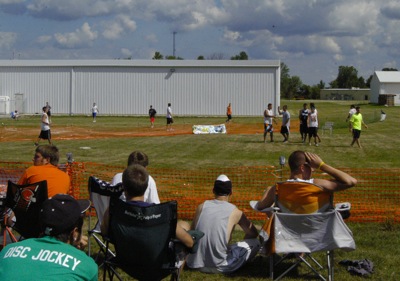Monday, August 3rd, 2009
EPA: Some help on the way
By Nancy Allen
Brian Miller, assistant manager at Grand Lake St. Marys State Park, said he is positive there will be "some positive things" happening in regard to helping Grand Lake with its water quality problems.
He made the statement during Saturday's meeting of the nonprofit Lake Improvement Association (LIA), but would not divulge further information. He would only say he met a couple of weeks ago with Ohio EPA officials and there could be some action announced yet this month.
Dina Pierce, a spokeswoman for the Ohio EPA, this morning confirmed "there are some things in the works," but still much that needs to be worked out before the information is made public. She said she did not know when any type of announcement would be made.
"When we are ready to roll it out, we may have a community meeting up there, but at this point it's too unrefined to talk about," she said.
Since Memorial Day weekend, a lot of attention has been focused on the lake's blue-green algae, which gives the lake its characteristic green color. A warning was issued that weekend to let lake-users know the algae is producing a toxin that can cause health issues for humans and animals.
The scientific community does not know what triggers blue-green algae to produce the toxin at some times and not at others.
A man in the audience at Saturday's meeting asked Miller if there is a way to see the toxin in the lake.
Miller answered "no," but warned him to stay away from what looks like green paint floating on top of the water because that is a full-fledged algae bloom, which could produce the toxin.
Miller also said some black, sewage-smelling material, which some lake residents reported floating to the surface in channels about six weeks ago, was decomposing organic matter, based on EPA testing.
LIA Technical Committee Chairman Tom Rampe said this smelly organic matter comes to the surface when there is not enough oxygen in the water. Huge algae blooms use up oxygen in the lake depleting it of dissolved oxygen.
Under budget matters, Miller said that Ohio State Parks statewide will receive a $4.3 million cut this year, which will translate to a 31/2 percent cut at Grand Lake St. Marys State Park.
"This is going to cut some seasonal hours and cause the reduction of one full-time staff person who left for another job," he said. "The good thing is the dredge budget will stay the same as last year."
Miller also said in his report that the lake's water level is at zero; the state park hopes to place a Geotube filled with dredge material along the lake's shore for shoreline protection; and the park intends to pull stumps from the lake this fall.
Wayne Bostic of GHD Inc., based in Chilton, Wisc., talked to LIA members about anaerobic digesters, which convert many types of organic waste into power.
The company currently has two anaerobic digesters operating in Ohio, one at a Fort Recovery poultry farm and another at a dairy in Montpelier. All total, the company has 57 digesters operating in 40 states in the U.S. and 17 under construction.
Bostic said "most anything smelly" can be used as a power source in anaerobic digesters such as manure, bacon grease, crushed fruit and even raw fish parts leftover from a fish processing facility.
"In Vermont they are dumping algae into a digester," he said.
The city of Celina is looking into securing grant money to fund such a project as a way to use the lake's abundance of blue-green algae.



